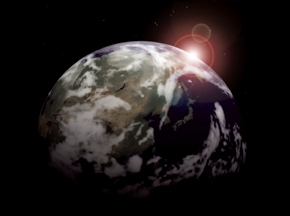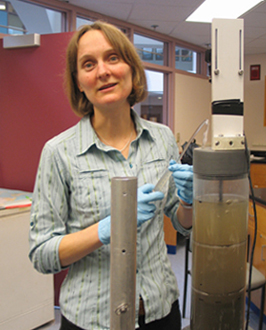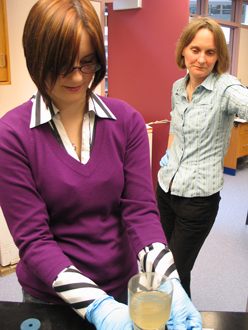Mucking About in the Name of Science
AFTER GETTING BACHELOR'S degrees in chemistry and environmental engineering, Australian Linda Kalnejais went to work for the Waters and Rivers Commission in Perth doing water quality studies on the western coastal estuaries. The estuaries, Kalnejais notes, were all “really beautiful” but were suffering from problems caused by excess nutrients.
And while she was fascinated with the subject at hand it soon became apparent that she would need to pursue a Ph.D. to further her studies.
“I was lucky that my boss was always bringing in outside scientists to study these western Australian estuaries,” Kalnejais says. She notes that one of those scientists was David Heggie, a sediment chemist who did his Ph.D. work at the University of Alaska.
“After meeting David I was just amazed that someone could get paid to study mud! Here was this thing that looked like just like a lump of slime and dirt and we could actually work out chemical reactions and write formulas and do all sorts of modeling and mathematical analysis based on what we measured,” she exudes.
For Kalnejais that revelation was pay dirt. She moved to the U.S. and got her doctorate at the Massachusetts Institute of Technology-Woods Hole Oceanographic Institution Joint Program focusing on the mechanisms of contaminant release from the sediments of Boston Harbor. She then did two years of post-doctoral work at the University of California, Berkeley studying acid-mine drainage generation.
Kalnejais arrived at EOS in September 2008 and is today an assistant professor of oceanography in the Ocean Process Analysis Laboratory and the Department of Earth Sciences.
Her focus on coastal water quality – both estuaries and the coastal zone – is a natural fit at OPAL while her interest in studying sediments adds a new dimension to the center’s work, a large part of which is centered around the carbon cycle in the coastal ocean region.
Kalnejais specializes in analyzing trace metals in water and sediments and has begun looking at trace metal contamination and nutrient release from sediments in Great Bay. Although UNH sediment studies from the 1980s in Great Bay provide a solid baseline, “we know very little about what’s happened to trace metals since then,” Kalnejais says.
Great Bay is relatively free from current input of trace metals – such as chromium, cadmium, zinc, lead, copper, and silver – but historical contamination raises the possibility that these metals could be re-released from sediments through either natural processes or human disturbances like dredging. So Kalnejais studies the chemical and physical mechanisms that might be either safely sequestering trace metals deep in the mud or bringing them back into play in the water column.
And, Kalnejais says, “Learning about the mechanisms that are occurring right in our backyard will allow me to extend studies to more contaminated regions without having to do as much field work in those areas.”
Her work on sediment processes will eventually add an extra component to OPAL’s work on carbon cycling. For the time being, however, she continues to focus her efforts on better quantifying and understanding how nutrients and contaminants are re-released from sediments and potentially made available to the marine environment.
Kalnejais, along with graduate student Jillian Lennartz, collects sediment cores from various parts of Great Bay and conducts sediment “resuspension” experiments in the lab by carefully simulating how water flow at various velocities (stress) stirs up the top millimeter or so of sediment.
“We’re trying to work out the relationship between stress on the surface of sediments and the release of contaminants. In the spring and summer we’ll be doing experiments in the field so we can compare the results from these smaller-scale lab experiments to validate what actually happens in nature,” says Kalnejais.
She notes that the sediment resuspension process releases a surprising amount of dissolved material and that after these erosion events some suspended material will remain in the water column for days. “And that material is enriched in trace metals, and so it means that resuspension is a really powerful way of moving contaminants around. We are determining the residence time of these particles in water bodies to model where the pollutants are moving to and what happens to them along their journey.”
In addition to these resuspension experiments, Kalnejais and Lennartz take additional sediment cores, section them very carefully in an oxygen-free environment to avoid changes in chemistry (there is no oxygen in sediments just below the surface layer) and analyze both the water and solid material to get a clear idea of the chemical composition of the sediments and how that relates to the impact of erosion.
“We get a solid understanding of the chemistry of the sediments from our measurements on the cores we collect, and it’s exciting to combine this information with all the data we get from these erosion experiments. More than ever before, we are starting to understand how a very dynamic process like resuspension influences water quality.” -DS
Linda Kalnejais
Photo by D.Sims, UNH-EOS |
“After meeting David I was just amazed that someone could get paid to study mud! Here was this thing that looked like just like a lump of slime and dirt and we could actually work out chemical reactions and write formulas and do all sorts of modeling and mathematical analysis based on what we measured,” she exudes.
For Kalnejais that revelation was pay dirt. She moved to the U.S. and got her doctorate at the Massachusetts Institute of Technology-Woods Hole Oceanographic Institution Joint Program focusing on the mechanisms of contaminant release from the sediments of Boston Harbor. She then did two years of post-doctoral work at the University of California, Berkeley studying acid-mine drainage generation.
Kalnejais arrived at EOS in September 2008 and is today an assistant professor of oceanography in the Ocean Process Analysis Laboratory and the Department of Earth Sciences.
Her focus on coastal water quality – both estuaries and the coastal zone – is a natural fit at OPAL while her interest in studying sediments adds a new dimension to the center’s work, a large part of which is centered around the carbon cycle in the coastal ocean region.
Kalnejais specializes in analyzing trace metals in water and sediments and has begun looking at trace metal contamination and nutrient release from sediments in Great Bay. Although UNH sediment studies from the 1980s in Great Bay provide a solid baseline, “we know very little about what’s happened to trace metals since then,” Kalnejais says.
Great Bay is relatively free from current input of trace metals – such as chromium, cadmium, zinc, lead, copper, and silver – but historical contamination raises the possibility that these metals could be re-released from sediments through either natural processes or human disturbances like dredging. So Kalnejais studies the chemical and physical mechanisms that might be either safely sequestering trace metals deep in the mud or bringing them back into play in the water column.
Jillian Lennartz Photo by D.Sims, UNH-EOS |
Her work on sediment processes will eventually add an extra component to OPAL’s work on carbon cycling. For the time being, however, she continues to focus her efforts on better quantifying and understanding how nutrients and contaminants are re-released from sediments and potentially made available to the marine environment.
Kalnejais, along with graduate student Jillian Lennartz, collects sediment cores from various parts of Great Bay and conducts sediment “resuspension” experiments in the lab by carefully simulating how water flow at various velocities (stress) stirs up the top millimeter or so of sediment.
“We’re trying to work out the relationship between stress on the surface of sediments and the release of contaminants. In the spring and summer we’ll be doing experiments in the field so we can compare the results from these smaller-scale lab experiments to validate what actually happens in nature,” says Kalnejais.
She notes that the sediment resuspension process releases a surprising amount of dissolved material and that after these erosion events some suspended material will remain in the water column for days. “And that material is enriched in trace metals, and so it means that resuspension is a really powerful way of moving contaminants around. We are determining the residence time of these particles in water bodies to model where the pollutants are moving to and what happens to them along their journey.”
In addition to these resuspension experiments, Kalnejais and Lennartz take additional sediment cores, section them very carefully in an oxygen-free environment to avoid changes in chemistry (there is no oxygen in sediments just below the surface layer) and analyze both the water and solid material to get a clear idea of the chemical composition of the sediments and how that relates to the impact of erosion.
“We get a solid understanding of the chemistry of the sediments from our measurements on the cores we collect, and it’s exciting to combine this information with all the data we get from these erosion experiments. More than ever before, we are starting to understand how a very dynamic process like resuspension influences water quality.” -DS
by David Sims, Science Writer, Institute for the Study of Earth, Oceans, and Space. Published in Fall2009 issue of EOS .


